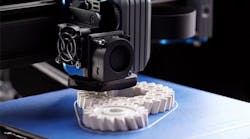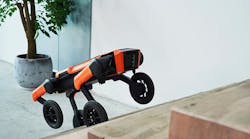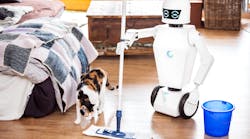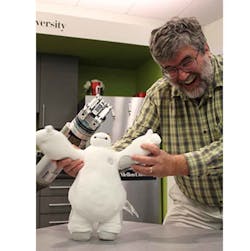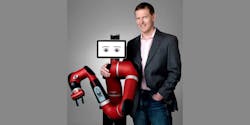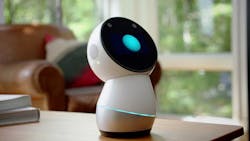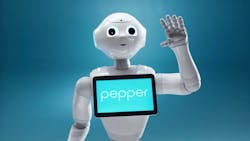As a teen in the mid-1970s, Chris Atkeson learned what it feels like to slowly lose your freedom.
About once a month, Atkeson would receive a call from his grandmother. His grandfather had ALS, the debilitating neurodegenerative disease that ruthlessly robs a person of the strength to do even the simplest of tasks. These calls meant it was Atkeson’s turn to hop in the family station wagon and drive several miles through Washington D.C. suburbs to provide assistance.
“He would fall out of his chair, basically slide onto the floor and my grandmother wasn’t strong enough to lift him up,” Atkeson recalls. “I was her robot. I would pick him up and put him in the chair, or help him to bed.”
That’s one major reason why the gregarious professor, who works out of Carnegie Mellon University’s Robotics Institute and Human-Computer Interactions Institute, has spent his career trying to get robots into homes. He wants to make sure people don’t have to leave theirs to live in an assisted living facility.
“Right now I am taking care of my mother,” Atkeson says.
“There isn’t anybody that’s going to take care of me. There’s tremendous turnover in nursing homes, these people are paid minimum wage so it’s hard to find good help and frankly, most old people are not eager to move to a nursing home. If we can give them the technology to stay in their own home and control their own lives, they are going to be a lot happier.”
Unfortunately, help isn’t on the way yet. If a guy with two degrees from Harvard, a Ph.D. from MIT, and more than three decades working with robots doesn’t have one to take care of his mom, the technology clearly hasn’t arrived.
The first robot worker, Unimate, started on a GM assembly line in 1961.
Collaborative robots, machines that can work safely near people in a manufacturing environment, came out in force only this decade. So far, they have improved productivity while relieving humans of strenuous, sometimes injury-inducing tasks.
Despite fears that they will replace us all someday, in the coming decades, Atkeson, as well as several other roboticists, believe much of the aging population will rely on automated assistance just to get up in the morning.
If you are one of the 75.4 million baby boomers (age 57 to 75), this should be quite disconcerting, considering that the Greatest Generation has you to assist them and you have Gen X (41 to 56), which won’t outnumber you until 2028, according to the Pew Research Center.
But is there any mechanism even close to ready?
“There’s been one successful robot in the home: the Roomba,” says Jeff Burnstein, president of the Robotic Industries Association.
“Fifty years and we’ve gotten a vacuum. That’s kind of disappointing because we thought we were getting 'The Jetsons.'”
Metal Monsters and Marshmallow Men
Atkeson believes the solution is soft robotics, lightweight machines covered in inflatable material that would be safer and cheaper to deploy than anything currently out there.
“We had to find a way to make robots absolutely safe even if their computers crashed and it fell on somebody,” says Atkeson.
His team’s work with a soft robotic arm that combs hair and assists with getting dressed inspired the most popular example of soft robotics: Baymax. The marshmallowy health care assistant/crime fighter from Disney’s “Big Hero 6,” who thinks hugs are the best medicine, didn’t take shape until after the movie’s director saw what was going on in Atkeson’s cluttered lab filled with silicone skin, pneumatic actuators, and groggy grad students.
The movie introduced the world to a kinder, gentler alternative to the “metal monsters” Atkeson spent much of his career working on. Those, he argues, just won’t do when it comes to assistive health care.
"It’s like asking a bulldozer to brush your teeth,” he says. “If you’re too scared to let your robot touch you, that robot is useless, no matter how skillful it is.”
Until recently, the only mass-produced robots were metal monsters, brainless behemoths bolted to the ground in sparking automotive plants. And like with monsters, the hugs they dole out are usually deadly.
In 1979, a one-ton production line robot at a Ford casting plant in Michigan crushed the skull of a worker trying to retrieve parts near the robot. It was the first death attributed to a robot. Two years later, a Japanese worker climbed over a safety fence to work on a robot. After inadvertently brushing up against the power switch, the 37-year-old worker was shoved into a gear-cutting machine and killed.
The best defense against more gruesome deaths was better cages and unmitigated robot segregation.
“About 65% of the robots bought today are in the automotive industry: welding, painting, moving big hunks of metal,” cites Jim Lawton, Chief Product and Marketing Officer at Rethink Robotics.
“They are in cages, they are unapproachable. If you get near them, you get killed.”
Between a Rock and a Soft Place
We are in the midst of a paradigm shift, though. At the International Collaborative Robots Workshop in Pittsburgh on Oct. 15, hosted by the RIA, several robotics companies—including Rethink—filled the Omni William Penn Hotel’s ballrooms, their new breed of robots swaying and gyrating under sparkling chandeliers, inches from human contact. In factories, they may work with humans to assemble electronics. Other times they work with other robots, to cut sheet metal, for example.
Scanners and proximity sensors monitor speed and separation, signaling the cobot to slow down or stop if a person is too close.
The only workplace violence Rethink Robotics’ two cobots—the two-armed Baxter and one-armed Sawyer—have ever been accused of are killing manufacturing jobs.
This reminds Lawton of his favorite Arthur C. Clarke quote: “We tend to overestimate technology in the short term, and underestimate it in the long term.”
He concedes that certain jobs will be taken by robots; much like cars took the place of the horse and buggy. But that’s not as close as people portend.
“In all of the deployments we’ve done, and we asked every company, not one has of them has laid off a person due to a collaborative robot,” Lawton says. He believes it has the reverse effect, actually democratizing manufacturing. Basically, his argument, and that of automation advocates everywhere, is that any manufacturer can do more work with fewer people and remain competitive, not just the ones who can afford a huge workforce or outsource.
Burnstein led a study that positively links employment and robot sales, indicating to him robots aren’t the job terminators people fear they are. “Outsourcing and the inability to compete, those are the killers,” Burnstein says.
The biggest threat to American manufacturing right now is time, Lawton says.
“A lot of the people in manufacturing are men deep into their 50s, many about to retire,” Lawton says. “Millennials don’t want to do manufacturing jobs. Parents are not encouraging their kids to get into manufacturing. Finding qualified people is a struggle.”
Sawyer, the current automated ingénue many think will be more disruptive than Kanye West at an awards ceremony, started shipping this fall. Early adopters such as GE have been impressed with the 0.1-mm of tolerance to perform even the most delicate placement of a circuit board or fuse.
Lawton says that China will be a big market, with hundreds of Sawyers possibly populating a single factory. By 2017, China will have the most manufacturing robots, the International Federation of Robotics predicts.
Both Sawyer and Baxter have touch screens that turn into cartoonish eyes when working, looking at where they are moving. Lawton reports that plants have dressed them like they are part of the crew, popping on a Patriots hat or whatever sports team is near them.
Advances like these represent the first steps to getting automated healthcare companions in the home. The next difficult challenge is making them mobile.
Go Cart
German-based KUKA Robotics has begun an early-stage development project to do just that. By combining an omnidirectional motion platform, a 7-axis LBR iiwa (intelligent industrial work assistant), and the Sunrise controller to regulate the sensors and functions, the company has created the KUKA Mobile Robotics iiwa.
KUKA actually trained its KR-16 robots to pour beers and mix martinis, although Ryan says putting that on a mobile cart around several inebriated people might be not enough reward for the risk right now. Though this video suggests it's on its way:
Lawton foresees physical robots becoming ubiquitous in the next 15 years, just in time for the last boomer to retire—if that word still exists in 2030.
The first social home robots are actually here already.
Jibo, developed at MIT by Cynthia Breazeal, is an adorable three-axis bot that looks like a flightless, armless Eve from "WALL-E" and acts as a personal assistant. The company says it’s “part of the family.”
Pepper, a four-foot-tall humanoid mobile bot with a screen on its chest and a penchant for empathy, is currently sold in Japan for $1,600 (plus a $200 monthly fee for insurance and data).
Lawton appreciates these companion bots, but reminds us that there is another school of thought: “I’m looking for these robots to do what I don’t want to do so I have more time to become companions with other people.”
